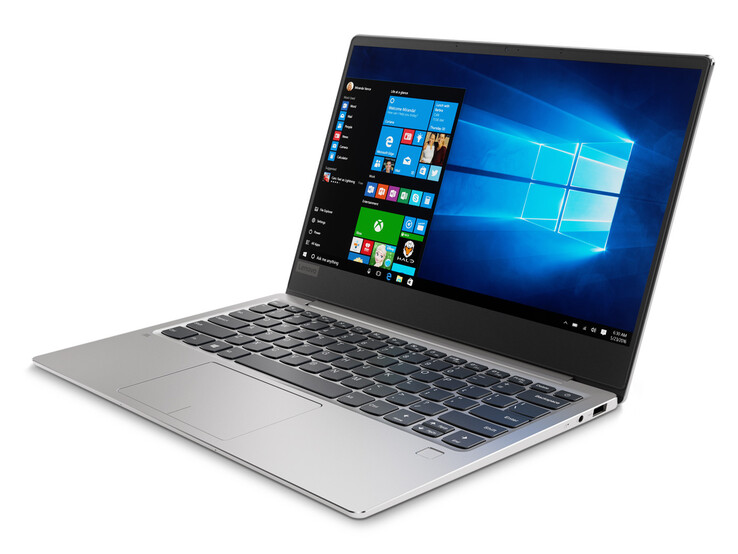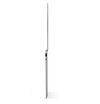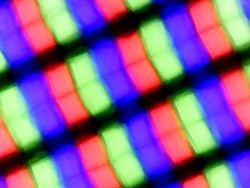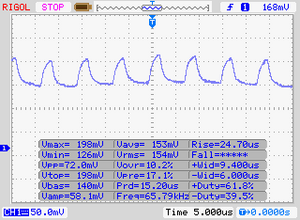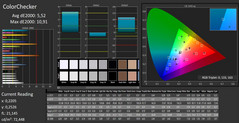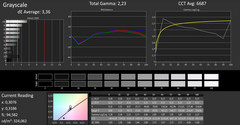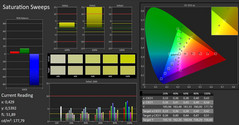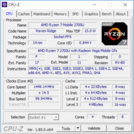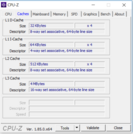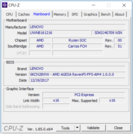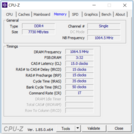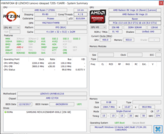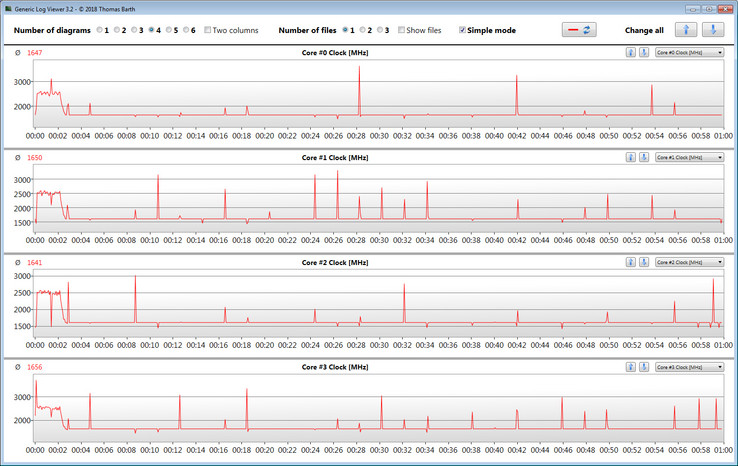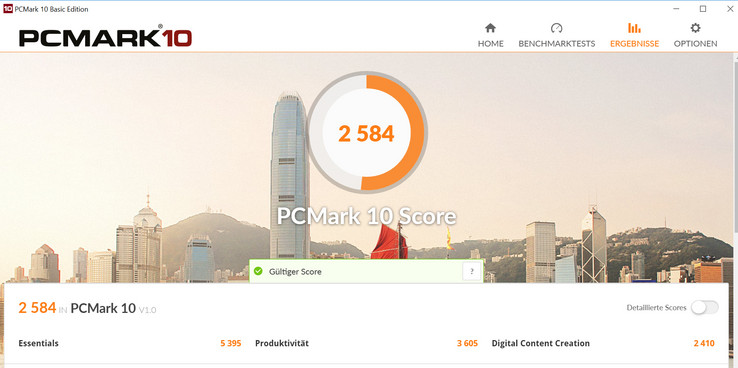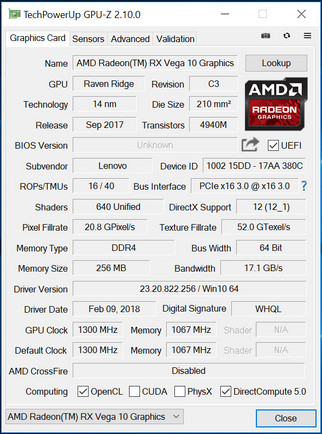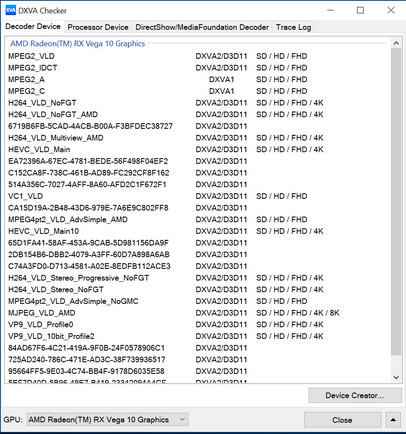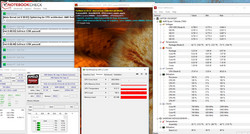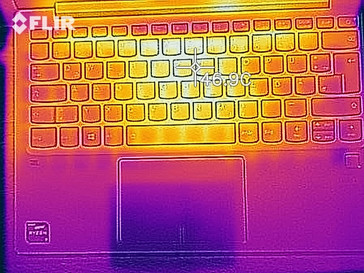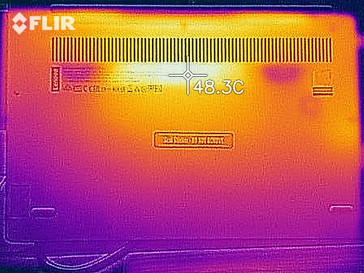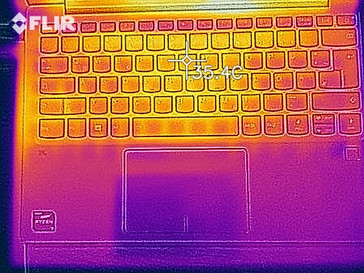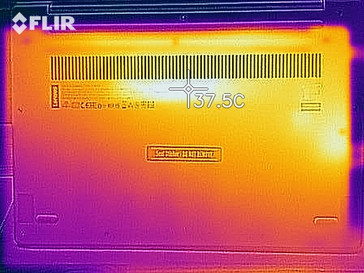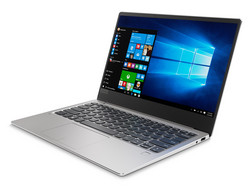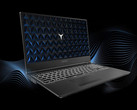Lenovo IdeaPad 720s-13ARR (Ryzen 7 2700U, RX Vega 10) Laptop Review

We have seen plenty of the Lenovo IdeaPad 720s variants in our offices, having already reviewed the aesthetically identical 720s-13ARR (Ryzen 5 2500U) and the 720s-13IKB (Core i5-8250U). The focus of this review is the 720s-13ARR that is equipped with an AMD Ryzen 7 2700U Accelerated Processing Unit (APU).
We have chosen the Dell Inspiron 13 7370, ASUS ZenBook S UX391U and the Acer Spin 5 SP513-52N as comparison devices.
We will not be examining the case, the connectivity, the input devices nor the display or the speakers in this review as we have already covered these areas in our previous IdeaPad 720s reviews. Please see our IdeaPad 720s-13IKB review for information on these areas.
Display
The 720s-13ARR has a 13.3-inch matte IPS display with a 1920x1080 native resolution. According to tests, our test device’s display is an LG Philips LP133WF4-SPB1 panel, which is the same as those used in the other IdeaPad 720s models that we have tested. The values of these displays differ slightly, as no two displays are completely identical.
X-Rite i1Pro 2 measured our test device’s display as having a 0.32 cd/m² black value, which helps the display achieve a solid 1,013:1 contrast ratio. This contrast ratio matches the better of our comparison devices. Likewise, the 293.4 cd/m² average maximum brightness is competitive.
One downside is Lenovo’s use of pulse-width modulation (PWM) to regulate brightness. PWM can cause eye strain and headaches with some people regardless of the frequency at which the display changes its brightness. We measure PWM at 65,000 Hz for brightness levels at and below 90%, which should be high enough to negate any ill effects with even those who are PWM sensitive. Ideally, though, we would prefer to see no PWM used to remove this risk of eye strain and headaches altogether.
| |||||||||||||||||||||||||
Brightness Distribution: 78 %
Center on Battery: 324 cd/m²
Contrast: 1013:1 (Black: 0.32 cd/m²)
ΔE ColorChecker Calman: 5.52 | ∀{0.5-29.43 Ø4.78}
ΔE Greyscale Calman: 3.36 | ∀{0.09-98 Ø5}
83% sRGB (Argyll 1.6.3 3D)
55% AdobeRGB 1998 (Argyll 1.6.3 3D)
60.8% AdobeRGB 1998 (Argyll 3D)
83.1% sRGB (Argyll 3D)
65.1% Display P3 (Argyll 3D)
Gamma: 2.23
CCT: 6687 K
| Lenovo Ideapad 720S-13ARR IPS, 1920x1080, 13.3" | Asus ZenBook S UX391U IPS, 1920x1080, 13.3" | Acer Spin 5 SP513-52N-54SF IPS, 1920x1080, 13.3" | Dell Inspiron 13 7370 IPS, 1920x1080, 13.3" | Lenovo Ideapad 720S-13ARR IPS, 1920x1080, 13.3" | Lenovo Ideapad 720S-13IKB IPS, 1920x1080, 13.3" | |
|---|---|---|---|---|---|---|
| Display | 5% | 12% | 3% | 0% | -1% | |
| Display P3 Coverage (%) | 65.1 | 64.4 -1% | 69.8 7% | 66.7 2% | 65.2 0% | 64.3 -1% |
| sRGB Coverage (%) | 83.1 | 90.5 9% | 94.6 14% | 86.2 4% | 83.3 0% | 82.3 -1% |
| AdobeRGB 1998 Coverage (%) | 60.8 | 65.2 7% | 69.3 14% | 63 4% | 60.9 0% | 60.2 -1% |
| Response Times | -46% | -47% | -57% | -23% | -19% | |
| Response Time Grey 50% / Grey 80% * (ms) | 31 ? | 44.8 ? -45% | 49 ? -58% | 46 ? -48% | 36 ? -16% | 35 ? -13% |
| Response Time Black / White * (ms) | 20 ? | 29.2 ? -46% | 27 ? -35% | 33 ? -65% | 26 ? -30% | 25 ? -25% |
| PWM Frequency (Hz) | 65000 ? | 1000 ? | 201 ? | 128000 ? | 131000 ? | |
| Screen | 1% | 15% | -6% | 9% | -6% | |
| Brightness middle (cd/m²) | 324 | 299 -8% | 295 -9% | 301 -7% | 299 -8% | 335 3% |
| Brightness (cd/m²) | 293 | 300 2% | 276 -6% | 291 -1% | 306 4% | 303 3% |
| Brightness Distribution (%) | 78 | 92 18% | 88 13% | 87 12% | 90 15% | 85 9% |
| Black Level * (cd/m²) | 0.32 | 0.26 19% | 0.27 16% | 0.33 -3% | 0.27 16% | 0.46 -44% |
| Contrast (:1) | 1013 | 1150 14% | 1093 8% | 912 -10% | 1107 9% | 728 -28% |
| Colorchecker dE 2000 * | 5.52 | 5.6 -1% | 2.97 46% | 5.39 2% | 4.46 19% | 5.09 8% |
| Colorchecker dE 2000 max. * | 10.91 | 9.1 17% | 5.67 48% | 8.56 22% | 10.51 4% | 11.92 -9% |
| Greyscale dE 2000 * | 3.36 | 5.5 -64% | 3.12 7% | 5.93 -76% | 2.41 28% | 3.23 4% |
| Gamma | 2.23 99% | 2.47 89% | 2.45 90% | 2.6 85% | 2.29 96% | 2.18 101% |
| CCT | 6687 97% | 7533 86% | 6676 97% | 6358 102% | 6757 96% | 6214 105% |
| Color Space (Percent of AdobeRGB 1998) (%) | 55 | 58.9 7% | 62 13% | 56 2% | 55 0% | 54 -2% |
| Color Space (Percent of sRGB) (%) | 83 | 90.3 9% | 94 13% | 86 4% | 83 0% | 82 -1% |
| Colorchecker dE 2000 calibrated * | 2.6 | |||||
| Total Average (Program / Settings) | -13% /
-4% | -7% /
6% | -20% /
-11% | -5% /
3% | -9% /
-7% |
* ... smaller is better
Screen Flickering / PWM (Pulse-Width Modulation)
| Screen flickering / PWM detected | 65000 Hz | ≤ 10 % brightness setting | |
The display backlight flickers at 65000 Hz (worst case, e.g., utilizing PWM) Flickering detected at a brightness setting of 10 % and below. There should be no flickering or PWM above this brightness setting. The frequency of 65000 Hz is quite high, so most users sensitive to PWM should not notice any flickering. In comparison: 53 % of all tested devices do not use PWM to dim the display. If PWM was detected, an average of 8111 (minimum: 5 - maximum: 343500) Hz was measured. | |||
Performance
The 720s-13ARR is powerful enough for office and Internet-based applications, prices for which start at 700 Euros (~$819). Our test device is currently available for around 880 Euros (~$1030). Lenovo also sells the 720s-13IKB, which is otherwise identical to the 720s-13ARR except for being equipped with Intel Core processors. By contrast, the 720s-13ARR range is equipped with AMD Ryzen APUs.
Processor
Our test device is equipped with an AMD Ryzen 7 2700U APU that has a 15 W thermal design power (TDP). The Ryzen 7 2700U is a quad-core processor with a 2.2 GHz base clock speed that can boost up to 3.8 GHz when necessary. The APU can handle eight threads simultaneously thanks to Simultaneous Multithreading (SMT). This technology is equivalent to Intel's Hyper-Threading.
The APU operates at between 2.5 and 2.8 GHz during a Cinebench multithread benchmark, while three cores operate at 1.5 GHz and one at 3.4 GHz during single-threaded benchmarks. Our test device performs equally as well in benchmarks on battery power as it does on mains power.
We also tested the extent to which our test device can maintain boosted clock speeds by running Cinebench multithread benchmarks on a continuous loop for 30 minutes. The results are poor. Our test device initially scored 550 points, but this dropped to 356 points by the third benchmark pass. Our test device then maintained this score for the remaining tests. This is a 36% clock speed drop after just three passes. The turbo clock speed is hardly used in the first two passes, but it is no longer active by the third test. The clock speed even drops below the base clock speed to 1.6 GHz.
We would recommend buying the model with an AMD Ryzen 5 2500U APU if you are interested in a 720s-13ARR. The Ryzen 5 2500U variant is cheaper, but the two models score similarly in CPU benchmarks. Our test device simply cannot take advantage of the Ryzen 7 2700U’s potential power. It is worth considering the 720s-13IKB too, as its Intel Core i5-8250U processor scores around 50% higher than its AMD Ryzen counterparts.
| Geekbench 3 | |
| 32 Bit Multi-Core Score | |
| Acer Spin 5 SP513-52N-54SF | |
| Average AMD Ryzen 7 2700U (10423 - 12444, n=2) | |
| Lenovo Ideapad 720S-13ARR | |
| 32 Bit Single-Core Score | |
| Acer Spin 5 SP513-52N-54SF | |
| Average AMD Ryzen 7 2700U (3136 - 3361, n=2) | |
| Lenovo Ideapad 720S-13ARR | |
| Geekbench 4.0 | |
| 64 Bit Multi-Core Score | |
| Average of class Office (24040 - 41046, n=3, last 2 years) | |
| Acer Spin 5 SP513-52N-54SF | |
| Lenovo Ideapad 720S-13ARR | |
| Average AMD Ryzen 7 2700U (n=1) | |
| 64 Bit Single-Core Score | |
| Average of class Office (7340 - 7721, n=3, last 2 years) | |
| Acer Spin 5 SP513-52N-54SF | |
| Lenovo Ideapad 720S-13ARR | |
| Average AMD Ryzen 7 2700U (n=1) | |
| Geekbench 4.4 | |
| 64 Bit Multi-Core Score | |
| Average of class Office (16566 - 41544, n=10, last 2 years) | |
| Acer Spin 5 SP513-52N-54SF | |
| Lenovo Ideapad 720S-13ARR | |
| Average AMD Ryzen 7 2700U (5034 - 9169, n=3) | |
| 64 Bit Single-Core Score | |
| Average of class Office (4469 - 8042, n=10, last 2 years) | |
| Acer Spin 5 SP513-52N-54SF | |
| Average AMD Ryzen 7 2700U (3357 - 3610, n=3) | |
| Lenovo Ideapad 720S-13ARR | |
| JetStream 1.1 - Total Score | |
| Acer Spin 5 SP513-52N-54SF (Edge 41) | |
| Asus ZenBook S UX391U (Edge 42.17134.1.0) | |
| Lenovo Ideapad 720S-13IKB | |
| Lenovo Ideapad 720S-13ARR (Edge 42) | |
| Average AMD Ryzen 7 2700U (128.7 - 191.7, n=6) | |
| Acer Swift 3 SF315-41-R6J9 (Microsoft Edge 41.16299.371.0) | |
| Lenovo Ideapad 720S-13ARR | |
System Performance
The system performance is smooth though and we encountered no problems during testing. The PCMark results reflect our impression that the 720s-13ARR is powerful enough for office and Internet-based applications. The Intel-based 720s-13IKB scores higher in these benchmarks, but this will not be noticeable in daily use unless you plan to continually run the device at full load for extended periods.
| PCMark 8 Home Score Accelerated v2 | 3155 points | |
| PCMark 8 Creative Score Accelerated v2 | 3453 points | |
| PCMark 8 Work Score Accelerated v2 | 4391 points | |
| PCMark 10 Score | 2584 points | |
Help | ||
Storage Devices
Our test device is equipped with a 256 GB Samsung PM961 SSD. The M.2-2280 NVMe drive has about 185 GB free, with the remaining space used by Windows 10 and its recovery partition.
The drive performs well in CrystalDiskMark 3.0, but it is 18% slower than the average of PM961-equipped devices that we have currently tested. Our test device is also around 10% slower in CrystalDiskMark than the ASUS ZenBook S UX391U and the 720s-13IKB despite being equipped with the same drive.
Interestingly, our test device is 29% faster than its 720s-13ARR sibling, which is also equipped with a PM961 drive. Finally, our test device is considerably faster than our SATA III SSD-equipped comparison devices; SATA III is generally much slower than NVMe, so this is of no surprise.
| Lenovo Ideapad 720S-13ARR Samsung PM961 MZVLW256HEHP | Asus ZenBook S UX391U Samsung PM961 NVMe MZVLW512HMJP | Acer Spin 5 SP513-52N-54SF Micron 1100 MTFDDAV256TBN | Dell Inspiron 13 7370 Micron 1100 MTFDDAV256TBN | Lenovo Ideapad 720S-13ARR Samsung PM961 NVMe MZVLW128HEGR | Lenovo Ideapad 720S-13IKB Samsung PM961 MZVLW256HEHP | Average Samsung PM961 MZVLW256HEHP | Average of class Office | |
|---|---|---|---|---|---|---|---|---|
| CrystalDiskMark 3.0 | 10% | -37% | -53% | -29% | 8% | 16% | 68% | |
| Read Seq (MB/s) | 1532 | 1805 18% | 462.7 -70% | 476.8 -69% | 1755 15% | 1674 9% | 1627 ? 6% | 3104 ? 103% |
| Write Seq (MB/s) | 1261 | 1438 14% | 439.9 -65% | 458.3 -64% | 770 -39% | 1191 -6% | 1136 ? -10% | 2916 ? 131% |
| Read 512 (MB/s) | 906 | 654 -28% | 325.2 -64% | 351 -61% | 723 -20% | 658 -27% | 887 ? -2% | 899 ? -1% |
| Write 512 (MB/s) | 853 | 1107 30% | 361.9 -58% | 298.2 -65% | 163.7 -81% | 852 0% | 781 ? -8% | 2309 ? 171% |
| Read 4k (MB/s) | 49.02 | 47.75 -3% | 27.52 -44% | 20.79 -58% | 36.4 -26% | 51.8 6% | 53 ? 8% | 54.1 ? 10% |
| Write 4k (MB/s) | 95.2 | 101 6% | 91.6 -4% | 65.8 -31% | 69.5 -27% | 114.9 21% | 126.7 ? 33% | 114.1 ? 20% |
| Read 4k QD32 (MB/s) | 308.4 | 257.2 -17% | 247.3 -20% | 172.8 -44% | 292.4 -5% | 349.2 13% | 419 ? 36% | 463 ? 50% |
| Write 4k QD32 (MB/s) | 228.6 | 364.6 59% | 292 28% | 160.3 -30% | 124.7 -45% | 332.2 45% | 384 ? 68% | 370 ? 62% |
Graphics Card
The Ryzen 7 2700U integrates AMD Radeon RX Vega 10 graphics, which supports DirectX 12. This is the only source of graphics as the 720s-13ARR does not include a dedicated GPU. Our test device performs poorly in benchmarks, primarily for two reasons.
Firstly, the GPU only reaches 1,000 MHz despite having a 1,300 MHz maximum clock speed. We speculate that this is because of TDP settings and insufficient cooling.
Secondly, the system runs in single-channel mode, which restricts GPU performance. We would typically advise adding a second RAM module to enable dual-channel mode, but the RAM is soldered so the system is stuck in single-channel mode.
The Acer Swift 3 SF315-41-R6J9 shows what the Radeon RX Vega 10 can do when running in dual-channel mode. The Swift 3 scores between 39% and 67% higher than our test device depending on the benchmark. This improved benchmark performance corresponds with a noticeable improvement in graphics performance in daily use too.
| 3DMark 11 Performance | 2489 points | |
| 3DMark Cloud Gate Standard Score | 7255 points | |
| 3DMark Fire Strike Score | 1210 points | |
Help | ||
Gaming Performance
The 720s-13ARR is not designed with gaming in mind, but its GPU is powerful enough for some gaming sessions at the right settings. We achieved a relatively smooth experience when playing games at minimum to medium graphics settings at 1280x720.
We have included a breakdown of the games that we tested our test device against below.
| low | med. | high | ultra | |
|---|---|---|---|---|
| BioShock Infinite (2013) | 65.7 | 42.2 | 25.4 | 8 |
| Dota 2 Reborn (2015) | 55.3 | 32.6 | 12.5 | 11.8 |
| Farming Simulator 17 (2016) | 77.9 | 44.4 | 14.8 | |
| Rocket League (2017) | 58.5 | 17.7 | ||
| Dirt 4 (2017) | 38.2 | 14.2 | ||
| Team Fortress 2 (2017) | 49.3 | 43.5 | 27.8 | |
| F1 2017 (2017) | 26 | 15 | 13 |
| F1 2017 - 1280x720 Ultra Low Preset | |
| Acer Swift 3 SF315-41-R4W1 | |
| Average of class Office (n=1last 2 years) | |
| Acer Spin 5 SP513-52N-566U | |
| Lenovo Ideapad 720S-13ARR | |
| Average AMD Radeon RX Vega 10 (n=1) | |
Emissions & Energy
Fan Noise
Our test device can reach up to 31.1 dB(A) at idle, but often the device is near-silent, and the fan is off. Expectedly, fan noise increases under load, but not drastically so. For example, our test device only reached a maximum of 37.7 dB(A) when running an hour-long combined FurMark and Prime95 stress test. Overall, the 720s-13ARR manages its fan noise well, and it is on par with other similarly priced devices.
Noise level
| Idle |
| 30.7 / 30.7 / 31.1 dB(A) |
| Load |
| 33 / 37.7 dB(A) |
 | ||
30 dB silent 40 dB(A) audible 50 dB(A) loud |
||
min: | ||
Temperature
Our combined FurMark and Prime95 stress test runs equally as well with the device on battery power as it does on mains power. In both scenarios, the CPU and GPU temporarily operate at high clock speeds before the APU drops to between 750 and 800 MHz and the GPU to 200 MHz.
The 720s-13ARR runs relatively hot even at idle, but not excessively so. Our test averages 28.4 °C at idle, with the palm rest remaining slightly cooler at an average of 26.2 °C. The palm rest stays relatively cool under load too, with our test device averaging just under 30 °C. The rest of the device gets significantly hotter though, with three areas reaching above 40 °C.
It is worth noting that the Ryzen 5 2500U-equipped 720s-13ARR runs slightly cooler than our test device. Additionally, our test device only reaches these maximum surface temperatures because we subject it to extreme load; you will not see these kinds of surface temperatures in daily use.
(±) The maximum temperature on the upper side is 43 °C / 109 F, compared to the average of 34.3 °C / 94 F, ranging from 21.2 to 62.5 °C for the class Office.
(±) The bottom heats up to a maximum of 40.2 °C / 104 F, compared to the average of 36.8 °C / 98 F
(+) In idle usage, the average temperature for the upper side is 28.2 °C / 83 F, compared to the device average of 29.5 °C / 85 F.
(+) The palmrests and touchpad are cooler than skin temperature with a maximum of 30.4 °C / 86.7 F and are therefore cool to the touch.
(-) The average temperature of the palmrest area of similar devices was 27.6 °C / 81.7 F (-2.8 °C / -5 F).
Speakers
Lenovo Ideapad 720S-13ARR audio analysis
(-) | not very loud speakers (69 dB)
Bass 100 - 315 Hz
(-) | nearly no bass - on average 15.9% lower than median
(-) | bass is not linear (15.6% delta to prev. frequency)
Mids 400 - 2000 Hz
(±) | higher mids - on average 7% higher than median
(±) | linearity of mids is average (9.4% delta to prev. frequency)
Highs 2 - 16 kHz
(+) | balanced highs - only 1.7% away from median
(±) | linearity of highs is average (7.1% delta to prev. frequency)
Overall 100 - 16.000 Hz
(±) | linearity of overall sound is average (22.7% difference to median)
Compared to same class
» 60% of all tested devices in this class were better, 8% similar, 32% worse
» The best had a delta of 7%, average was 21%, worst was 53%
Compared to all devices tested
» 66% of all tested devices were better, 6% similar, 28% worse
» The best had a delta of 4%, average was 24%, worst was 134%
Apple MacBook 12 (Early 2016) 1.1 GHz audio analysis
(+) | speakers can play relatively loud (83.6 dB)
Bass 100 - 315 Hz
(±) | reduced bass - on average 11.3% lower than median
(±) | linearity of bass is average (14.2% delta to prev. frequency)
Mids 400 - 2000 Hz
(+) | balanced mids - only 2.4% away from median
(+) | mids are linear (5.5% delta to prev. frequency)
Highs 2 - 16 kHz
(+) | balanced highs - only 2% away from median
(+) | highs are linear (4.5% delta to prev. frequency)
Overall 100 - 16.000 Hz
(+) | overall sound is linear (10.2% difference to median)
Compared to same class
» 7% of all tested devices in this class were better, 2% similar, 91% worse
» The best had a delta of 5%, average was 18%, worst was 53%
Compared to all devices tested
» 4% of all tested devices were better, 1% similar, 94% worse
» The best had a delta of 4%, average was 24%, worst was 134%
Power Consumption
The 720s-13ARR has relatively high power consumption, particularly at idle. Our test device consumes a maximum of 11.3 W at idle, which is considerably higher than the 720s-13IKB with its Intel processor. Our test device temporarily consumes a maximum of 38.5 W under load, but this quickly drops as the CPU and GPU start to throttle.
The included charger is rated at 45 W, so you will have no problem charging the device even when it is operating under maximum load.
| Off / Standby | |
| Idle | |
| Load |
|
Key:
min: | |
Battery Life
The 720s-13ARR has a 48 Wh battery, which is the same capacity as its Ryzen 5 2500U sibling and 2 Wh more than the 720S-13IKB.
Our test device last 6 h 38 m in our Wi-Fi battery life test during which we run a script that simulates the load required to render websites. For reference, we set the Windows 10 Power mode to balanced, turned energy-saving features off and set the display brightness to 150 cd/m².
The 720s-13ARR lasts significantly longer than its Ryzen 5 2500U-powered sibling, but the 720s-13IKB lasts a whopping three-and-a-half hours longer than our test device.
Pros
Cons
Verdict
The Lenovo IdeaPad 720s-13ARR is a solid device, but its poor cooling solution and TDP settings mean that it cannot fully exploit either its APU or its GPU. Worse still, Lenovo has limited the device to run in single-channel mode. This limits GPU performance and cannot be rectified. Performance is good enough for office and Internet applications, but CPU and GPU performance could be significantly better than they are.
The Lenovo IdeaPad 720s-13ARR cannot take advantage of its Ryzen 7 2700U APU to the extent that it performs at the same level as its cheaper sibling.
Positively, the NVMe SSD is fast and ensures solid system performance. Likewise, the backlit keyboard is impressive, and the Full HD display is bright and has a good contrast ratio. Unfortunately, the battery life is average at best.
That being said, we would recommend choosing the more expensive 720s-13IKB over either 720s-13ARR configuration. The 720s-13IKB has an Intel Core processor that is more consistent than the AMD APU powering our test device. Better still, the 720s-13IKB has a Thunderbolt 3 port, while both Ryzen models only have a USB Type-C port. The 720s-13IKB also has much longer battery life despite having a smaller battery. Overall, the 720s-13ARR can only compete with its Intel-powered sibling on price.
Lenovo Ideapad 720S-13ARR
- 07/26/2018 v6 (old)
Sascha Mölck




